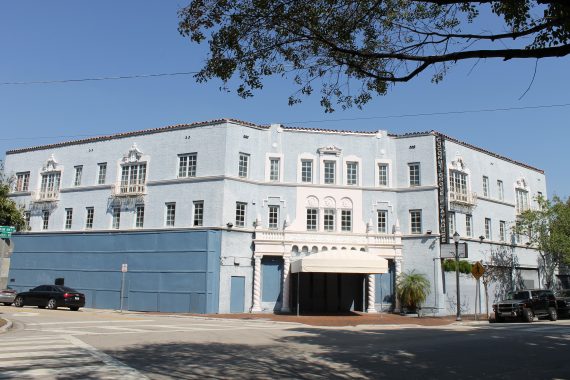The ambitious makeover plan for the Coconut Grove Playhouse is moving forward, despite strong opposition from some preservationists who don’t want to see a large portion of the historic property torn down.
Miami’s Historic and Environmental Preservation Board voted 4-1 on Tuesday to approve Miami-Dade County’s master site plan that calls for demolishing and rebuilding the theater’s auditorium and other interior structures, as well as constructing an attached parking garage with residential units. The $20 million renovation project is a partnership between the county, Florida International University and local theater company GableStage.
“Our entire goal is to do something wonderful for this community,” said Miami-Dade cultural affairs director Michael Spring. “And that something wonderful is doable and sustainable for the public.”
The state-owned property stopped operating as a theater in 2006 following the financial implosion of the non-profit organization that managed the Coconut Grove Playhouse. Six years later, ownership reverted to the state, and Miami-Dade partnered with FIU to create a plan for redeveloping and reactivating the theater. The county and the university signed a 99-year lease in 2014 with the purpose of developing a state-of-the art 300-seat performance hall and having the property designated a national historic site. GableStage was brought onboard to manage and program the playhouse as a regional theater and to collaborate with FIU in developing educational programs.
Two years ago, Miami-Dade hired a development team that included Jorge Hernandez, an architect with the structural engineering firm Douglas Wood Associates, and Bernardo Fort-Brescia, founder of Arquitectonica. They came up with a plan to restore the entire front facade of the playhouse to the original 1927 design by Keihnel and Elliott, at the time one of the premier architectural firms in America. The plan also calls for reestablishing the footprint of the original crescent-shaped lobby of the former movie house as a lush, tropical courtyard.
The team will also document portions of the playhouse that would need to be demolished and rebuilt in order to incorporate the same design elements, including Solomonic columns, in the newly reconstituted structure, Hernandez told historic preservation board members.
However, critics like Coral Gables-based architect Rich Heisenbottle said Miami-Dade’s plan was a matter of convenience after neglecting the playhouse for the past three years. “The county has not lifted one finger to protect it, clean it, let alone take out the garbage,” Heisenbottle said. “For its convenience, the county is proposing a vastly smaller theater under the guise of only restoring the front facade.”
Heisenbottle argued that the auditorium was in a “very restorable condition.” “Despite the many insensitive renovations and neglect over the years, the auditorium meets historic preservation criteria to a tee,” he said. “There are thousands of successfully restored theaters from Broadway to Main Street, and the Coconut Grove Playhouse should be one of them.”
